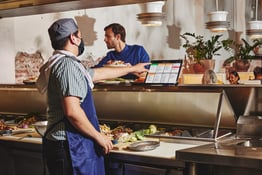As much as it is your food or your ambiance, your restaurant is your staff. And they’re hard to juggle. Keeping the right people on the line and working the front of house can make or break a night. They also present a real challenge when you’re scheduling full-time and part-time employees who require certain hours to keep them on the job, or just to keep them happy.
Since the dawn of time, the best restaurant managers have been a combination diplomat and math wiz. These days restaurant employee scheduling software has taken off much of that pressure. Using time-tracking tools, real-time data, and attendance updates, managers can easily adjust schedules in minutes on the fly. Other software features can crunch labor costs and project staffing needs for you, so you can, in theory, be sure you’re making money on a given shift.
Restaurant scheduling apps now account for pay rate, multiple shifts, and even staffing for different locations. You just need a computer or mobile device to get started using convenient calendars, messaging systems, and reporting capabilities.
No shade on Excel, but dedicated labor management software beats the pants off a spreadsheet.
What To Look for in the Best Restaurant Scheduling Software
The best employee scheduling systems account for time-off requests, hours, employee availability, and your budgets. From one central system, managers can align schedules for workers who are on staff or seasonal. Staffers and managers can notify one another of conflicts or standby shifts, open shifts or early outs, vacation days, parental leave, or emergencies.
Every shift scheduling software has its own unique features and functions. Whether or not you need them all depends on your shift planning needs. For instance:
- Does it have mobile access, so your restaurant staff can check their schedules on the fly?
- Does it offer drag-and-drop schedule templates to make setup hassle-free?
- Does it alert a staffer when you have last-minute shift openings or when you approve their time-off request?
- Does it have shift-swap parameters that make sure everyone hasn’t taken off the same Friday night?
- Does it let you easily compile and report your timesheets so you don’t have any payroll processing surprises come payday?
Or maybe your ideal staff scheduling software is bare-bones. If you’ve got a smaller operation, hey, don’t overcomplicate what you can do on the cheap.
Once you have an idea of what you need, hit up a salesperson at the company that looks like the best fit for your restaurant. See if you need to buy any hardware (you probably won’t) and make sure the software is designed for the restaurant industry (it probably is).
Nail down the fee structure, how often you’ll have to upgrade, and how to get customer support. Then ask for a free trial, to make sure you and your employees jibe with the user interface, team communication tools, notifications, and scheduling process. The nicest scheduling app in the world isn’t worth its price if you simply don’t like using it.
Scheduling Software Built To Manage Delivery Drivers
Look at Sauce. If you're running deliveries with your own team, Sauce makes it easy. Instead of juggling multiple delivery platforms, it's a restaurant delivery app that helps you take back control of your off-premise business. It helps you accept orders directly through your own branded channels, then routes those orders to your drivers or third-party couriers when needed.
Instead of juggling multiple delivery apps, Sauce brings everything into one place, so you can manage orders, dispatch, and logistics without the chaos. You keep more of each sale, including the delivery fees and tips, all while minimizing the commissions you’d normally pay to marketplaces. Plus, your drivers get a streamlined app to track deliveries, find optimized routes, and communicate in real time.
Scheduling Software When You Like Your Tech Simple and Strong
Look at 7Shifts. Trusted by the likes of Five Guys, 7Shifts promises quick schedule creation and a free mobile app for schedule updates and shift changes. Its artificial intelligence can automate your scheduling, build reports, and let staff message and trade shifts. Its scheduling features can forecast your staffing needs based on sales trends, with the goal of keeping you from over- or under-staffing.
It also integrates with POS systems and payroll operations to fuse your finances into a single platform. The interface is appealingly simple and easy to use, with a reliable clock-out and time clock system.
Scheduling Software Priced for Small Restaurants
Look at Better Chains. Their “workforce optimization software” includes a suite of modules designed with restaurants in mind, e.g., a clear calendar interface for scheduling, HR compliance, training, automatic scheduling, and a tool for staffers to arrange their own shift swaps (pending your approval).
Scheduling Software Built to Handle Multiple Teams
Look at CrunchTime Labor Management & Scheduling. If you manage a large team (or several teams), CrunchTime might be the right choice to juggle them across multiple locations. The platform checks each shift schedule against local, state, and federal labor laws.
It’s built to integrate with POS, HR, and payroll systems, as well as other apps, and managers’ notes. It also predicts your shift needs down to 15-minute increments, drawing from data sources up to and including the local weather forecast.
Scheduling Software for a Staff Who Roll Up Late and Leave Early
Look at Push Operations. Designed specifically for restaurants, Push advertises itself not just as a workplace management tool, but a one-stop-shop for everything labor-related, and counts such heavies as Denny’s and Boston Pizza among its clients.
It includes features to track time and request shifts as well as higher-level tasks such as on-boarding and compliance management. It also offers facial recognition software and geofencing to ensure accurate clock-ins and clock-outs — powerful tools that can reduce no-shows and drive accountability within your team.
Scheduling Software With a Long Track Record
Look at Restaurant365. Since all the way back in 2001, Restaurant365 has been offering a variety of restaurant-operations software, a deep and long-running specialization. Over the years they migrated into the cloud, but the core remains helping restaurants scale labor best practices by translating scheduling trends into smart data. Restaurant 365’s other tools include accounting, HR, inventory, and payroll suites, all of which can be bundled.
Scheduling Software for Restaurants That Don’t Think They Can Afford It
Look at Schedule 101. An employee scheduling solution designed by hospitality professionals, Schedule 101 is lean and straightforward, a good option for a smaller mom-and-pop shop looking to enter the digital age of labor management.
Hiring Software Built for When Your Schedule Falls Apart
Look at SnapShyft. Trying to bring in a dishwasher and a line cook at the last minute could eat through a general manager’s entire afternoon. Managers using SnapShyft can pull in a temporary worker who has been vetted and who has a verified work history for a flat fee rather than a cut (or the lion’s share) of your budget for that worker.
“It's designed to be a set it and forget it type of situation,” says Thor Wood, the founder of SnapShyft. “For example, ‘I need three servers, a cook, and a dishwasher at 4 pm,’ what are the days, etc., and that's it. Spend two minutes entering that work order, and you can do that through your mobile app or desktop.”
Scheduling Software for Restaurants That Only Need Scheduling Software
Look at Sling. It lets you arrange schedules, trade messages and photos, clock in, set reminder alarms, and doesn’t reach beyond those core features of lining out a schedule. Not to be confused with the streaming platform, Sling takes a democratic approach by allowing employees to sign up for shifts they'd like to work. The idea is to head off double bookings, tardiness, and absenteeism. It’s sleek and user-friendly.
Pick the Best Scheduling Software for Your Restaurant
Running a restaurant is hard enough, and your scheduling software should make life easier, not harder. The best tools help you handle schedule changes, organize shifts with simple task management, and make it easy for new employees to get up to speed.
It should let staff request time off quickly, automatically update schedules, and offer payroll integration to save time on back-office work. Most importantly, it should help you control labor costs — a major issue in the busy restaurant industry.
Look for scheduling tools that are easy to use for both managers and your team — and make sure staff can sign in or receive updates using just their phone number. If it saves you time and keeps everyone informed, it’s a win.
And if you need help sorting out your options, book a free consultation with a Back of House Expert.
[Photo by Ketut Subiyanto from Pexels]





